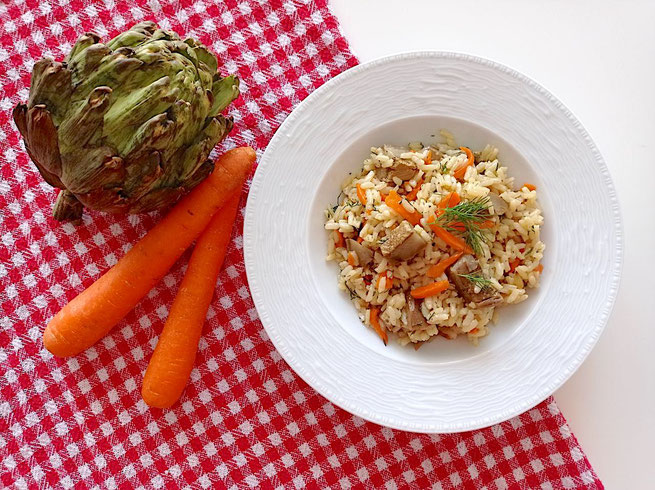
You know, we always talk about typical Turkish flavors and the scent of peppers, tomatoes and co. But that's actually only one side of the coin, because that describes much more of Anatolian cuisine. It is also what you most likely think of when you think of Turkish recipes. But then, especially when we move west of Turkey to the Mediterranean, there is a whole other palette of flavors. Less tomatoey, fruity and hearty, but more subtle and lighter. Today's Turkish recipe also belongs to this type: We cooked Enginarli pilav – rice with artichokes!
What is Turkish-style rice with artichokes?
If you live in the Mediterranean, you will enjoy the extensive artichoke season. You can find whole artichokes, artichoke bottoms, pickled artichokes and more artichokes everywhere – this part of Turkey is a true artichoke paradise.
So far, we have only introduced you to one artichoke recipe (Zeytinyagli Enginar, i.e. stuffed artichoke bottoms). The flavors of our Turkish-style rice with artichokes are very similar – and so delicious!
This was the first time in my life that I thought to myself about a meal: "If I were a vegetarian/vegan, I would eat this all the time."
It reminded me a lot of Central Asian plov. With less meat and fat, of course. The artichokes still give you a bit of a meaty flavor and the thin carrot sticks complete the taste. What's more, we are huge fans of rice dishes anyway. So it was only natural that we would also love this Turkish-style rice with artichokes.
However, the whole Turkish rice dish is rounded off with a few flavor twists: good, intense olive oil, dill, lemon and a hint of sweetness from sugar. These are typical ingredients when a lot of olive oil is used in Turkish cooking.

Preparation and serving suggestions for Turkish-style rice with artichokes
Preparing rice with artichokes is very simple. However, you will need artichoke bottoms, which are not available everywhere. You therefore have the option of visiting a Turkish supermarket, cleaning the artichokes yourself or buying the artichoke bottoms online*. In Turkey, you can buy the ready-made bottoms fresh in brine per piece or in jars all year round.
Enginarli pilaf is also a quick Turkish rice dish. You sauté onions in olive oil, add carrots, artichokes and rice, fry a little, season and cook. At the end, add chopped dill to the rice with artichokes – done!
Suggestion: Turkish-style rice with artichokes is often prepared with spring onions instead of the usual onions. However, we are not fans of cooked spring onions. Of course, you can do this however you like.
In the end, we served the rice with artichokes Turkish-style with ayran and had a really tasty, somehow hearty, but then again light, full-flavored rice dish.
However, it's best to try the rice with artichokes for yourself, as we couldn't imagine what it would taste like at first. Be sure to let us know if you enjoyed the Enginarli pilav as much as we did! Afiyet olsun :-)

Enginarli Pilav recipe: Turkish-style rice with artichokes
Ingredients (for 2-3 portions)
- 2 artichoke bottoms* (more if desired)
- 1 onion
- 1 large carrot
- 160 grams or 3/4 cup rice
- 3 full tbsp olive oil
- 1 tsp sugar
- juice of half a lemon
- a handful of dill
- salt
Preparation
Step 1: Cut the onion into thin rings (do not chop). Sauté them in olive oil until translucent.
Step 2: Meanwhile, peel the carrot and cut it into short, thin sticks. Add them to the onions. After a good minute, add the artichokes cut into mouthfuls. Mix everything together.
Step 3: Add the rice to the pan and fry everything a little over a medium heat. Mix constantly so that the rice does not brown.
Step 4: Add salt, sugar and lemon juice. Pour 400 ml of water into the pan. When everything is boiling, turn the heat all the way down (level 2) and leave the rice to finish cooking with the lid on.
Step 5: Never open the lid while cooking! When the water has visibly evaporated, turn off the heat and leave the rice with artichokes on the stove with the lid closed for at least 10 minutes. Meanwhile, chop the dill.
Step 6: Stir in the dill and serve.

Write a comment